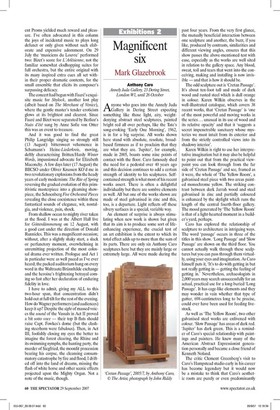Magnificent six
Mark Glazebrook Anthony Caro Annely Juda Gallery, 23 Doing Street, London Wl, until 26 October Anyone who goes into the Annely Juda Gallery in Dering Street expecting something like those light, airy, weightdenying abstract steel sculptures, painted bright red all over perhaps, like the Tate's song-evoking 'Early One Morning', 1962, is in for a big surprise. All works shown here stand with absolute, resolute, broadbased firmness as if to proclaim that they are what they are. 'Jupiter', for example, made in 2005, boasts some nine points of contact with the floor. Caro famously shed the need for a pedestal over 40 years ago and this decision continues to add a certain strength of identity to his sculptures. Selfcontained strength is what most of his recent works assert. There is often a delightful individuality but there are sombre elements as well. All but one of the works shown are made of steel galvanised in zinc and this, too, is a departure. Light reflects off these silvery surfaces in a special, variable way.
An element of surprise is always stimulating when new work is shown but given that its aim is to produce some sort of lifeenhancing experience, the crucial test of an art exhibition is the extent to which its total effect adds up to more than the sum of its parts. There are only six Anthony Caro sculptures here but they are mainly large or extremely large. All were made during the past four years. From the very first glance, the mutually beneficial interaction between one sculpture and another, the buzz, if you like, produced by contrasts, similarities and different viewing angles, ensures that this show passes the above-mentioned test with ease, especially as the works are well sited in relation to the gallery space. Any blood, sweat, toil and tears that went into the conceiving, making and installing is now invisible — and that is how it should be.
The odd sculpture out is 'Cretan Passage'. It's about ten-foot tall and made of dark wood and rusted steel which is dull orange in colour. Karen Wilkin observes in the well-illustrated catalogue, which covers 38 recent works, that 'Cretan Passage' is 'one of the most powerful and moving works in the series ... unusual in its use of wood and its relative opacity' and that it 'suggests a secret impenetrable sanctuary whose mysteries we must intuit from its exterior and from the strictly controlled views into its shadowy interior'.
Karen Wilkin is right to use her interpretative imagination but it may also be helpful to point out that from the practical viewpoint you can look through from the far side of 'Cretan Passage' and see, framed as it were, the whole of 'The Yellow Room', a galvanised steel piece with two areas painted monochrome yellow. The striking contrast between dark Jarrah wood and steel galvanised in zinc and partially coloured is enhanced by the skylight which runs the length of the central fourth-floor gallery. The mood generated by 'The Yellow Room' is that of a light-hearted moment in a builder's yard, perhaps.
Caro has explored the relationship of sculpture to architecture in intriguing ways. The word 'passage' occurs in three of the titles in this show. 'Long Passage' and 'Slow Passage' are shown on the third floor. You cannot actually walk through these sculptures but you can pass through them virtually, using your eyes and imagination. As Caro himself puts it, 'It's to do with getting in but not really getting in — getting the feeling of getting in.' Nevertheless, archaeologists in 2,000 years may search unsuccessfully for an actual, practical use for a long-buried 'Long Passage'. It has cage-like elements and they may wonder in vain whether that type of gutter, 698-centimetres long to be precise, could ever have been used for feeding livestock.
As well as 'The Yellow Room', two other galvanised steel works are enlivened with colour. 'Slow Passage' has areas of dark red. 'Jupiter' has dark green. This is a reminder of Caro's special relationship with paintings and painters. He knew many of the American Abstract Expressionist generation personally and became a close friend of Kenneth Noland.
The critic Clement Greenberg's visit to Caro's Hampstead studio early in his career has become legendary but it would now be a mistake to think that Caro's aesthetic roots are purely or even predominantly American. If one of his two father figures was David Smith, then the other was Henry Moore with whom he worked in the Fifties. Caro has also made sculptures inspired by European painters such as Matisse, Manet and Monet. Picasso and Julio Gonzalez freed sculptors to assemble sculptures as opposed to carving or modelling them and, if Picasso stands for form, and Matisse for colour, then Caro stands for space in sculpture — enclosed space, contained space, open space and implied or suggested space.
I confess to being shocked to discover that such a great and prolific sculptor as Caro, born 1924 in Surrey, delayed going to Greece until 1985. It seems to have been partly a case of avoiding sculpture that aimed for highly finished perfection. Perhaps the implied space of 'Jupiter', shown here, will appease the Greek gods for Caro's delay.
























































 Previous page
Previous page